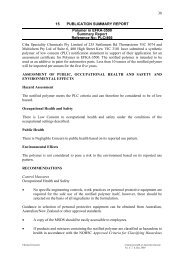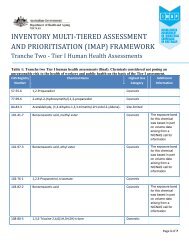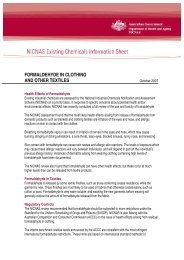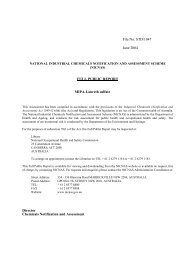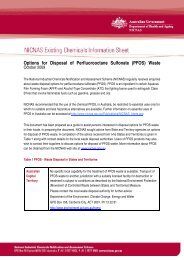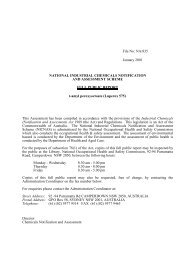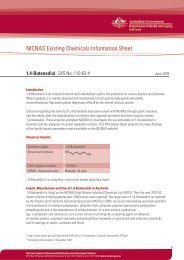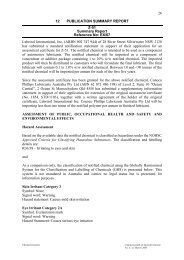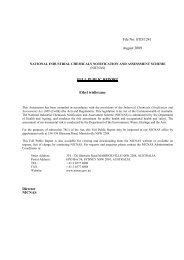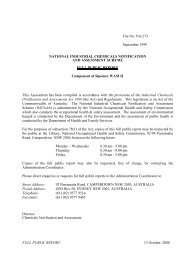GULFTENE C16-18 ISOMERISED OLEFINS - NICNAS
GULFTENE C16-18 ISOMERISED OLEFINS - NICNAS
GULFTENE C16-18 ISOMERISED OLEFINS - NICNAS
Create successful ePaper yourself
Turn your PDF publications into a flip-book with our unique Google optimized e-Paper software.
An extensive series of ecotoxicology tests have established that chemicals, which are close<br />
congeners of Gulftene 16-<strong>18</strong>, are generally non-toxic to both fresh water and marine<br />
organisms. However, some toxic effects have been observed when certain organisms are<br />
exposed to very high concentrations of the chemicals. These effects may be physical in<br />
origin. The drill cuttings may contain up to 10% of Gulftene 16-<strong>18</strong>, and it is conceivable that<br />
toxic levels could be exceeded in piles of drill wastes, or in the vicinity of these piles.<br />
When used as a component of drilling mud on off shore drilling, the available data indicates<br />
that Gulftene 16-<strong>18</strong> may present a hazard to the marine environment when it is discarded with<br />
waste drill cuttings. In particular, there are uncertainties surrounding issues of<br />
biodegradation, bioaccumulation and ecotoxicity at the likely high exposure levels. Further,<br />
it is to be noted that the physical, chemical and biological processes occurring in deposits of<br />
marine drill cuttings are not well understood, and it is only recently that appropriate<br />
techniques for examination of the spoil piles have been developed (Black 1999).<br />
Consequently, while the present environmental hazard assessment has been based on all<br />
presently available data, it is possible that future studies may indicate other factors which<br />
should be considered in evaluating the environmental hazard of discarded organic based<br />
drilling fluids.<br />
12. ASSESSMENT OF PUBLIC AND OCCUPATIONAL HEALTH AND SAFETY<br />
EFFECTS<br />
Toxicological data were not available on the notified chemical, Gulftene 16-<strong>18</strong>. However,<br />
the notifier submitted studies that had been conducted on a range of analogous alkenes (C12,<br />
C14, <strong>C16</strong> & C<strong>18</strong> alpha olefins; a blend of C12-<strong>C16</strong> alpha olefins; <strong>C16</strong> & C<strong>18</strong> internal<br />
alkenes; and C20-C24 branched and linear alkenes).<br />
Analogue alkenes have very low acute oral, dermal and inhalation toxicity. They are slight<br />
eye irritants, but not sensitising to skin. Kinematic viscosity measurements, including that for<br />
Gulftene 16-<strong>18</strong>, and investigations of aspiration potential in rats on a range of alkenes<br />
indicates that these alkenes present as an aspiration hazard.<br />
In acute skin irritation tests, analogue alkenes (except C20-C24 branched and linear alkenes)<br />
caused prolonged slight or slight to moderate skin irritation associated with desquamation.<br />
Repeat dermal application of C12-<strong>C16</strong>, <strong>C16</strong>-C<strong>18</strong>, or <strong>C16</strong> caused severe skin irritation.<br />
Repeated oral dose studies show that C20-24 alkenes branched and linear at high doses target<br />
the liver and adrenals. 1-Tetradecene at high doses also targets the liver and in male rats the<br />
kidney (hydrocarbon nephropathy – not relevant to human health). These alkenes are not<br />
neurotoxic, do not produce adverse effects on reproduction or foetal development and are not<br />
genotoxic.<br />
Assessment of the toxicological data of the alkene analogues against the NOHSC Approved<br />
Criteria for Classifying Hazardous Substances, indicate that Gulftene 16-<strong>18</strong> would be<br />
considered hazardous based on potential aspiration hazard and skin drying effects. The<br />
overall hazard classification is Harmful (Xn) and the following risk phrase and safety phrases<br />
relevant to health effects:<br />
FULL PUBLIC REPORT 26 April 2000<br />
NA/713 Page 90 of 100



